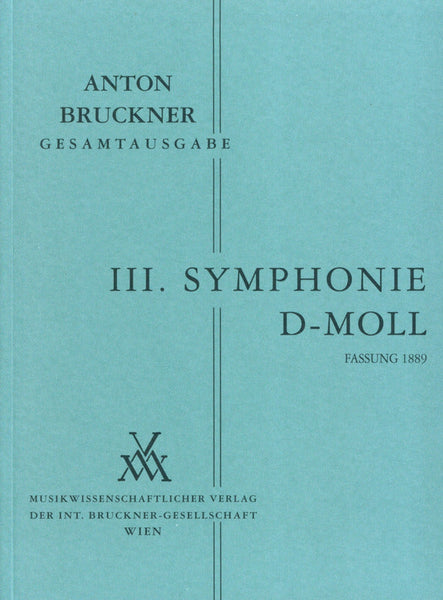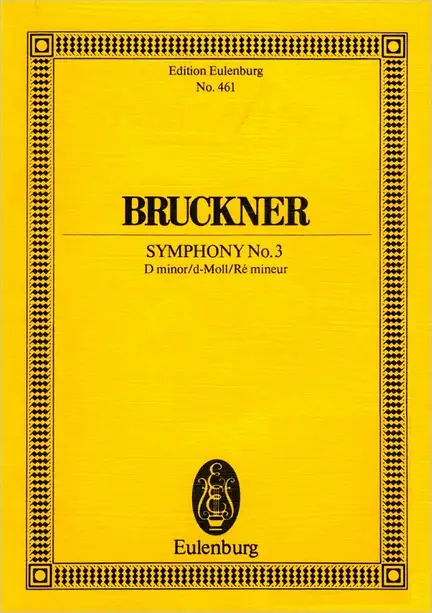Bruckner: Symphony 3
If I didn't care for how Bruckner lightly trod the C-minor key from his Symphony no. 2, I have no such problems here.
And if that previous symphony bore the subtitle 'Symphony of Pauses' the opening of Symphony no. 3 in D minor could have just as easily fit that description. Instead, this one is referred to as the 'Wagner Symphony', although due to cuts in various versions, one might not hear much of Wagner's music.
What I distinctly hear is Beethoven in the first-movement opening theme, one of an orchestral warm-up, ably showcasing the d-minor key. The descending theme (1 - 5 - 5 - 1) is a strong one too, one which reminds me of Richard Strauss when it appears in the brass. In the development, Bruckner adapts this music idea into an upward motion, showing possibilities of future triumph through its application.
The second theme is of course more lyrically effusive, and Bruckner's textures are more complex, with countermelodies and imitation coming and going all of the time. The first part of the melody is often fragmented by Bruckner, and stands solidly in this form with the opening tune, reminding me of Die Moldau or The Hebrides.
The third motive is more leaping and chromatic, and it is here where Bruckner overlaps duple and triplet quavers, giving into his penchant for rhythmic complexity. His thematic ideas have great breadth, and when the composer extends a building unresolved quality, elongating the time to a cadence, he truly hooks the listener in to his climaxes.
In all, the exposition of three themes takes anywhere between 8 - 10 minutes. In a 20-minute movement, a timing which might greatly vary depending on what edition is in use, this leaves a lot of space for the development, one where I feel Bruckner has truly arrived symphonically. The recapitulation brings back some of the silences from the opening and generally focuses his time on the opening material in a Coda-section finish.
The second movement is unsurprisingly pastorally idyllic, although the way Bruckner contrasts through sudden distant dynamics feels like there is something deeper at play than mere Austrian pastoralisms.
The second section is the one which reminds me of Wagner the most, where the endless melody is passed from the viola to the cellos and basses. Bruckner incorporates a contrasting hymn-like piousness every once in a while as well.
With a number of tempo changes, there is a fair bit of variety across the second movement too, never too far from a full ensemble climax.
Bruckner rarely thrusts the listener into dramatics at the start of a movement. Even in the third-movement Scherzo, the composer prefers to build towards a point rather than come right out and inflict musical whiplash upon the listener. Here, he builds via short chromatically rising harmonic motion as a short introduction.
 Bruckner nearly throws us into the fourth movement 'in media res'. A short opening of chromatic figure in the strings amongst sustained winds leads to a loud brass idea with the bass line moving in leaping octaves and shifting the harmonic movement chromatically as well.
Bruckner nearly throws us into the fourth movement 'in media res'. A short opening of chromatic figure in the strings amongst sustained winds leads to a loud brass idea with the bass line moving in leaping octaves and shifting the harmonic movement chromatically as well.What nearly sounds like a genial polka follows. I can't imagine a more contrasted musical relationship, and I still believe it to be a rather odd one. The tune almost sounds like a parlor song, as sing-songy as it is, although Bruckner tries to vary it with his way with orchestration.
A short third idea inserts itself, one which sounds heterophonic to my ears, with its unison octaves being set only a half semiquaver apart, instilling some unusual dissonance and texture. Of course, these ideas all come and go with some frequency and all providing a general feeling of building towards a conclusion. As mentioned in the first movement, the composer teased a triumphant form of his opening motive, and it is finally realized here, with a short jaunt in major and a final unison minor button. Best of all, I think Bruckner stays true to the titled key of D minor throughout the work, an appreciable aspect of this symphony.
Perhaps I should have mentioned Bruckner's Third Symphony revisions and editions, for this composition is well known for having so many to its name. The ones I know best are the 1877 and 1889 second and third revisions as edited by Nowak. I am generally unfamiliar with the last Rättig revision, as well the 1873 first version, nor the 1874 revision Carragan edition of it.
Some consider Symphony no. 3 to be the arrival of a mature composer, while others wait for the famous Symphony no. 4 to make such proclamations. It is easier to hear a progression of Bruckner's composing considering the determined use of minor keys in these early symphonies, mainly choosing C and D minor as his titled settings. Perhaps I will wait to make my opinion known.
1954: Knappertsbusch
1977: Blomstedt (Berlin)
1980: Karajan
1993: Solti
2011: Schaller
2016: Nelsons
For
now, we will have a
very basic list of Bruckner reviews above. Those recordings I mentioned
as an example in the text above, or performances I have come to respect
which await future reviews, are listed above in greened bold. My actual reviews can be found in the typical Oozy Keep orange. Until we at The Oozy Channel Keep
have gotten ourselves up and running, this should suffice and we can
reorganize the page a little more coherently in the future.

